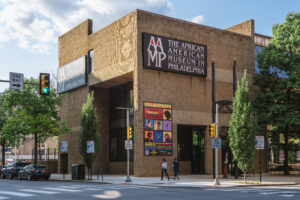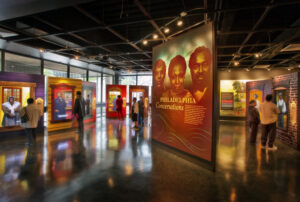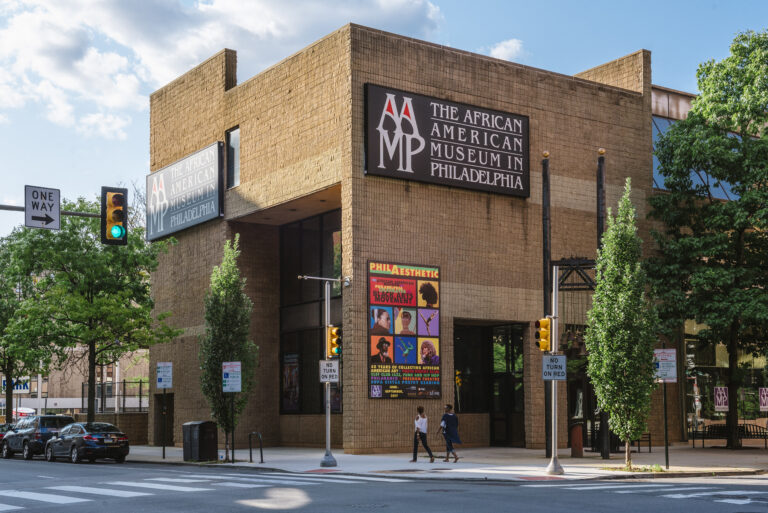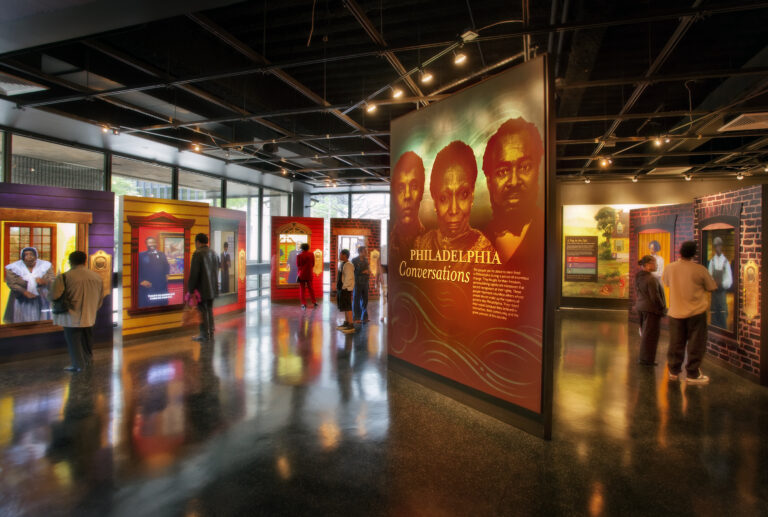African American Museum in Philadelphia
Essay
Opened to the public in 1976, the African American Museum in Philadelphia (AAMP) was the first major museum of African American history and culture established by an American municipality. Founded as part of Philadelphia’s Bicentennial celebration, the museum emerged at a moment when many Americans were reconsidering the place of Black history and culture in American history and arguing for its inclusion in Americans’ understanding of their past and themselves. However, from the museum’s inception tensions developed over who would lead it, where it would be located, what community it would serve, and what stories it would tell. Over the next fifty years, it struggled administratively and struggled to find an identity in a city already crowded with art and history museums. Still, the push for a more inclusive history and continued financial support from the city allowed it to survive.

The AAMP, originally called the Afro-American Historical and Cultural Museum, was part of a larger shift toward creating institutions for Black art and history collections. Although an independent 501(c) (3) nonprofit since its formal inception in 1975, the museum was unique because of the city’s role in its founding and its creation as part of the United States Bicentennial. As part of the 1976 celebrations, the museum responded to the civil rights movements of the 1960s, which raised awareness of inequality in the legal treatment of African Americans and in the treatment of Black history in narratives of the past. While telling a more diverse and accurate history of the United States and Philadelphia, a Black history exhibit at the Bicentennial also had the potential to promote pride and positive self-image in Philadelphia’s Black communities and cross-racial understanding in a racially divided city.
The need for a coordinated approach to the inclusion of Black history in the celebrations came to the attention of Bicentennial planners by 1974, although Philadelphia had chartered its Bicentennial planning commission (eventually known as Philadelphia ‘76 Inc.) seven years before, in 1967. In May 1974, Lawrence Dunbar Reddick (1910-95), a professor of history at Temple University, wrote to the planners to raise concerns about the lack of representation of Black history at the Bicentennial. In a long letter to William Rafsky (1919-2001), chairman of Philadelphia ‘76, he asked: “How did it happen that the plans for the bicentennial celebration at Philadelphia resulted in virtual exclusion of blacks from active participation and a distortion of the role of the black people in the building of ‘American civilization’?” Rafsky responded by sharing information about planned programs and existing collaborators. He also invited Reddick to meet with him and, ultimately, to be part of a steering committee for what came to be the AAMP.
Protests Reverse a Funding Cut
This did not facilitate the smooth development of the project. In December 1974, Mayor Frank Rizzo (1920-91) cut funding for the Black history museum. He restored it a few days later, however, after public protests and questions about why a Mummers Museum could be built in time for the Bicentennial, but a Black history museum could not be.
Even more visible was the prolonged debate in 1975 over where the city should locate the museum. Following a survey of various sites across Center City and North Philadelphia by architect Theodore Cam (1929-2001), a site at Sixth and Pine Streets emerged as the most desirable. The site’s advantages included proximity to the subway, the highway, and the historically significant Mother Bethel AME Church and the Seventh Ward, which in the nineteenth and early twentieth centuries had been the heart of Philadelphia’s Black community. By the 1970s, however, the neighborhood had been redeveloped as predominantly white, upscale Society Hill. The Society Hill Civic Association, which was mostly white, protested that the size and scale of the proposed museum building would bring too much traffic and would be detrimental to the character of the neighborhood. The association members specified that they were objecting not to the concept of a Black history museum but to the lack of input from the existing community, but the events nonetheless highlighted racial exclusions in the city. Ultimately, the protests in Society Hill delayed the project long enough to force organizers to select a new site for the museum so it could open in 1976. The site at Seventh and Arch Streets was only a block from the Independence Mall tourist area, but it was awkwardly located behind modern office buildings. In addition, its hasty design was not ideal for exhibits or the care of collections.
From the start, the museum struggled to establish an identity. Among its problems was its inability to establish sustainable sources of revenue. The city funded construction, but the museum was meant to fund itself as an independent nonprofit with only partial governmental support. Without an endowment or a preexisting donor base, this proved difficult. Also, lacking funding and effective leadership, the museum could not develop as an institution on the level of its peer museums. It was meant to complement—and even critique—not only the Bicentennial but also legacy institutions like the Historical Society of Pennsylvania, the Library Company of Philadelphia, and the Atwater Kent Museum. However, collection-building was difficult because of the lack of funds, competition for support from other institutions, and the seeming sparsity of surviving artifacts related to Black history. At the same time, its origins as a history museum often overshadowed its participation in the art world as seen, for example, in the works it commissioned for its opening from Romare Bearden (1911-88) and John Rhoden (1916-2001).
In its first decade, the museum went through seven directors and struggled to maintain a professional staff and an adequate environment for borrowed art and artifacts. It did collaborate with Charles Blockson (1933-2023) to display items from his collection in the 1981 exhibit “Of Color, Humanitas and Statehood,” but Blockson had reservations about the museum’s ability to properly care for the collection and ultimately donated it to Temple University in 1984.
Highlighting Promise vs. Reality
Still, the museum’s presence and its programs were meaningful for Black Philadelphians. In a rich challenge to mainstream histories, its narrative moved from life in Africa to enslavement and abolition in the United States and then followed the Black experience through the Great Migration, the Harlem Renaissance, and post-World War II fights for civil rights. It highlighted the disconnect between the equality and freedom promised in the Declaration of Independence and the reality of Black life in America and in Philadelphia over two hundred years.
The museum seemed to hit its stride after Rowena Stewart (1932-2015) took the job of executive director. During her seven-year tenure from 1985 to 1992, she focused on telling the story of Black Philadelphia with exhibits like “The Sounds of This City: Afro-American Music in Philadelphia” and “Let This Be Your Home,” which explored the Great Migration through the personal stories of Philadelphians. In 1986, she acquired the art and archives of Anna Russell Jones (1902-95), a twentieth-century Philadelphia artist and designer, and Jack T. Franklin (1922-2009), a prominent photojournalist who worked locally and nationally from the 1940s through the 1980s. She also initiated ambitious programs in oral history and community collecting. Her efforts aimed to simultaneously engage the community and build a collection, twin problems that plagued the museum from the start.
Stewart and her immediate predecessor also made progress with fundraising, but it did not last beyond their tenures. At its lowest points, the museum survived because of financial support from the city, but the money it received was never enough to address the budget shortfalls that impeded the maintenance of a professional staff, an adequate facility, and a strong collection. For the twenty years following Stewart’s leadership, the museum continued to see a rotating cast of administrators and financial crises. At some times this was due to internal mismanagement. At other times, it was due to broader cuts to funding for arts and culture or chronic under-support for Black institutions. Amid these troubles, the museum changed its name in 1997, becoming the African American Museum in Philadelphia, a name that administrators hoped would better capture the museum’s identity and the place it aimed to occupy in the city.
Building Partnerships

A new period of stability emerged when Romona Riscoe Benson (b. 1959) served as the museum’s director from 2005 through 2012. Benson built corporate and other partnerships, and she oversaw production of “Audacious Freedom,” a multimedia installation offering a sweeping history of Philadelphia’s Black community in America’s first hundred years. Benson’s successors as director, including Patricia Wilson Aden (b. 1959) from 2012 to 2020, maintained the stability of the institution and expanded its imprint in the Philadelphia arts scene with exhibits of Black artists and collaborations with community institutions, such as a much-heralded joint exhibit with the Pennsylvania Academy of the Fine Arts that opened in 2023. In 2022, the city announced that the museum would finally have a new home. Plans called for moving the museum to the former Family Court Building next to the Free Library of Philadelphia on the Benjamin Franklin Parkway. However, no funding was guaranteed.
Despite its struggles, the AAMP strived to realize its potential for telling the stories of Black Philadelphians that too often had been neglected in histories of the city. The museum’s founding as a city institution helped it survive, and its official status as the designated African American museum in Philadelphia made it a logical place for that storytelling. However, in part because it originated from the city’s white administration rather than the city’s Black community and in part because it lacked the centuries-old collections of other local institutions, the museum had an uncertain place in Philadelphia’s landscape of historical memory that often overshadowed its underappreciated engagement with Philadelphia’s Black art and artists.
Mabel Rosenheck is the Director of Education and Exhibition Planning at LancasterHistory in Lancaster, Pennsylvania, and the author of many articles on Philadelphia’s historical and cultural organizations. (Author information current at time of publication.)
Copyright 2023, Rutgers University
Gallery
Backgrounders
Connecting Headlines with History

